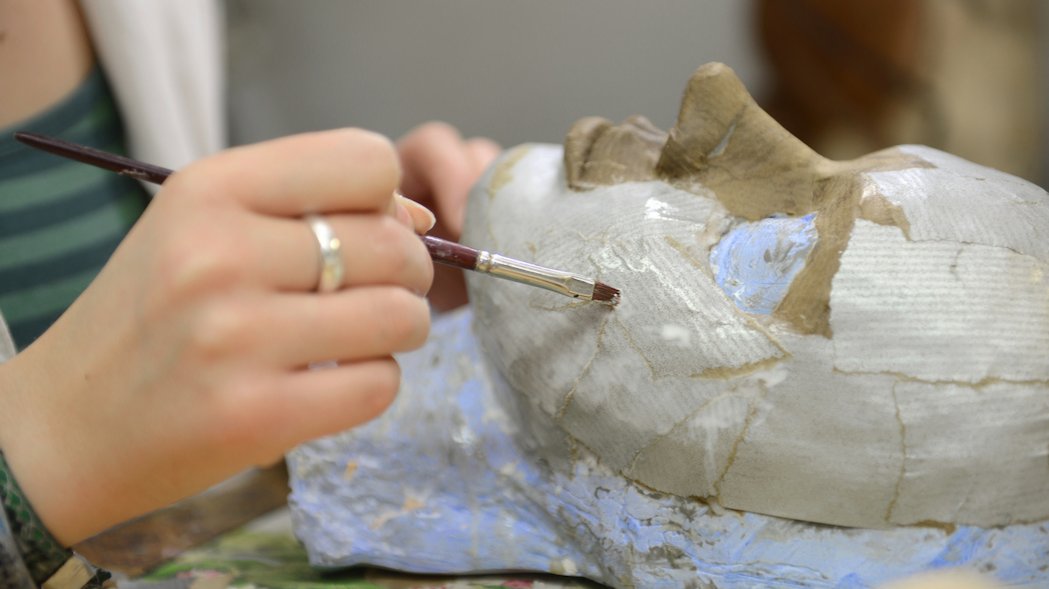Art studies
Anyone who is creative, has a head full of ideas, can express their artistic skills with different materials or is simply interested in the effect of art will find a wide range of opportunities in this field of study.

Overview of the academic discipline
The fine arts, art studies (respectively art history) and art education form the three pillars of this field of study.
- The fine arts are divided into two main areas: free arts and applied arts. Free art includes painting, graphic art, sculpture and photography, including all three-dimensional works such as objects and installations. The applied arts include gold and silversmithing, ceramics, textile art and stage design, whereby there are numerous overlaps with the fields of graphic design, media art, textile design, product design and so on. The transition to the liberal arts is also sometimes fluid.
- Art history or art studies is essentially concerned with the historical development of the visual arts from antiquity to the present day.
- At the centre of art education is the teaching of art and the aesthetic phenomena of everyday life in our society.
Which topics are included in the curriculum?
- The undergraduate degree programme in Fine Arts provides basic academic and practical knowledge in art, art history, art theory and design using pictorial, plastic or digital methods. Possible modules include illustration, aesthetics and cultural philosophy, art theory, art and design history.
- In art history, the focus is on academic and practical basic knowledge of architecture, sculpture and pictorial artworks from different eras. Possible modules include Fine Art and Architecture, History of Modern Art, History of Medieval Art and Christian Archaeology.
- Academic and practical basic knowledge, e.g. on pedagogy and didactics, art history and art education, play a role in art education. Possible modules include artistic thinking and acting, artistic design, visual arts and their mediation or general pedagogy.
- In art studies, the focus is on modules such as classical art history, Greek and Roman art, iconography, early modern art and the theory and history of art studies.
In order to be admitted to an art degree programme, prospective students must submit samples of artistic and creative work in addition to their higher education entrance qualification/entrance qualification for universities of applied sciences and demonstrate a particular artistic aptitude/suitability for the degree programme as part of a selection or aptitude test procedure. Criteria for selection are a portfolio with independent artistic works, written examinations and, in most cases, a selection interview.
It is also possible to study without a higher education entrance qualification if you have outstanding artistic talent. However, this does not apply to degree programmes that conclude with the first state examination for a teaching profession. Prospective art teachers may also have to provide proof of foreign language skills.
What are the requirements?
Important school subjects for studying art include German, history, foreign languages and, of course, art.
What study programmes are there to choose from?
Undergraduate study is possible at art colleges, universities, teacher training colleges and some universities of applied sciences. Undergraduate and postgraduate degree programmes are offered - some in the form of combined bachelor's degree programmes (e.g. art education), some in diploma programmes. The degree programmes are called, for example, Liberal Arts, Illustration, Painting/Graphics, Visual and Art History and Art Education.
What job opportunities are there after graduation?
Fine arts graduates can work in the fields of sculpture, painting or artistic drawing. They often work freelance.
A degree in art history leads to the following fields of work: Exhibition management, planning, art, cultural management or distribution, sales (art, antiques trade). Art historians are mainly employed in museums, galleries, in the art/antiques trade, in research and teaching as well as in academic institutions.
Art educators work in adult education, art education or media and cultural education.
